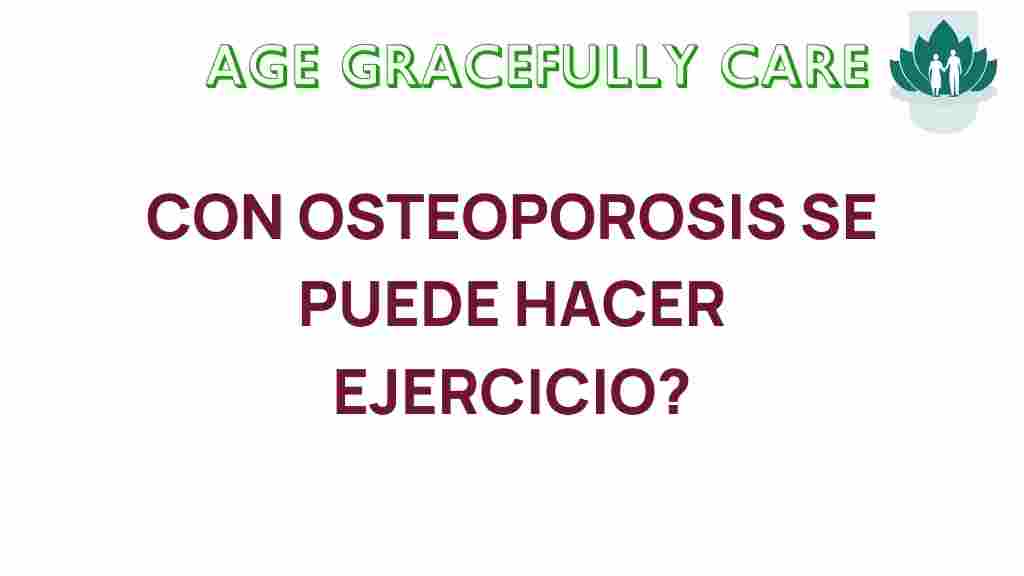Can You Exercise with Osteoporosis? Discover the Surprising Truth
Osteoporosis is a condition characterized by weakened bones, making them more susceptible to fractures. Many individuals diagnosed with osteoporosis may wonder whether they can safely exercise. The answer is not only a resounding yes, but exercise can also be a vital component of managing osteoporosis. In this article, we will explore the relationship between osteoporosis and exercise, focusing on how physical activity can enhance health, mobility, and overall wellness.
Understanding Osteoporosis
Osteoporosis affects millions of people worldwide, particularly older adults. Here are some key points to understand:
- What is Osteoporosis? Osteoporosis is a bone disease that occurs when the body loses too much bone, makes too little bone, or both. This results in bones that are porous and fragile.
- Risk Factors: Age, gender, family history, body frame size, and certain medications can increase the risk of developing osteoporosis.
- Symptoms: Often called a “silent disease,” osteoporosis usually does not show symptoms until a fracture occurs.
Understanding these aspects is crucial for anyone looking to maintain bone health through exercise.
The Role of Exercise in Bone Health
Regular exercise plays a pivotal role in improving bone health and preventing the progression of osteoporosis. Here’s how:
- Increases Bone Density: Weight-bearing and resistance exercises stimulate bone formation and increase bone density.
- Enhances Muscle Strength: Strength training improves muscle mass, which supports skeletal structure and reduces the risk of falls.
- Improves Balance and Coordination: Exercises that enhance balance reduce the likelihood of falls, which is critical for those with osteoporosis.
- Promotes Overall Wellness: Physical activity boosts mood and mental health, contributing to a better quality of life.
Types of Exercises Beneficial for Osteoporosis
When it comes to exercise, not all types are equally beneficial for people with osteoporosis. Here are some recommended activities:
1. Weight-Bearing Exercises
These exercises force you to work against gravity. They include:
- Walking
- Jogging
- Dancing
- Stair climbing
2. Resistance Training
Using weights or resistance bands to strengthen muscles and bones can significantly benefit bone density. Examples include:
- Lifting weights
- Bodyweight exercises (e.g., squats, push-ups)
- Resistance band exercises
3. Balance and Flexibility Exercises
Improving balance and flexibility is crucial in preventing falls. Consider these:
- Yoga
- Tai Chi
- Balance exercises (e.g., standing on one foot)
How to Start an Exercise Program with Osteoporosis
Starting an exercise program can be daunting, especially with osteoporosis. Here’s a step-by-step guide:
Step 1: Consult Your Doctor
Before starting any exercise program, it’s essential to consult your healthcare provider. They can provide guidance tailored to your health status and needs.
Step 2: Set Realistic Goals
Establish achievable fitness goals. Consider starting with short sessions and gradually increasing the duration and intensity:
- Begin with 10-15 minutes of activity.
- Gradually aim for at least 30 minutes on most days of the week.
Step 3: Choose the Right Activities
Select exercises that are safe and suitable for your level of fitness. Focus on activities that promote strength, balance, and flexibility.
Step 4: Incorporate Variety
To keep your routine interesting and comprehensive, include a mix of:
- Weight-bearing exercises
- Resistance training
- Balance exercises
Step 5: Listen to Your Body
Pay attention to how your body responds to exercise. It’s normal to feel some muscle soreness, but sharp pain or discomfort should not be ignored. Modify your routine as needed.
Troubleshooting Tips for Exercising with Osteoporosis
As you embark on your exercise journey, you may encounter some challenges. Here are tips for overcoming common issues:
- Fear of Injury: Start slowly and choose low-impact activities. Gradually increase intensity as you build confidence.
- Pain or Discomfort: If you experience pain during an exercise, stop immediately. Consult a healthcare professional to address any concerns.
- Lack of Motivation: Consider working out with a friend or joining a class to stay motivated. Setting achievable milestones can help as well.
Maintaining Mobility and Fitness as You Age
As we age, maintaining mobility and fitness becomes increasingly important, especially for individuals with osteoporosis. Here are additional tips to ensure a lifelong commitment to exercise:
- Stay Consistent: Try to make exercise a regular part of your daily routine.
- Adapt Your Exercises: As you progress, adapt your exercises to meet your evolving needs and abilities.
- Stay Educated: Keep learning about osteoporosis and exercise. Resources like the National Osteoporosis Foundation can provide valuable information. Visit NOF for more.
Conclusion
In conclusion, exercising with osteoporosis is not only safe but essential for maintaining bone health, improving strength, and enhancing overall wellness. By understanding your condition, consulting with healthcare professionals, setting realistic goals, and maintaining a varied exercise routine, you can enjoy the benefits of fitness without compromising safety.
Remember, incorporating exercise into your daily life can significantly reduce the risk of falls and fractures, allowing for greater mobility and quality of life. Embrace the journey towards better health and wellness, and discover the surprising truth that you can indeed exercise with osteoporosis.
For more information on how to stay active with osteoporosis, check out our detailed guide here.
This article is in the category Health and created by AgeGracefullyCare Team
